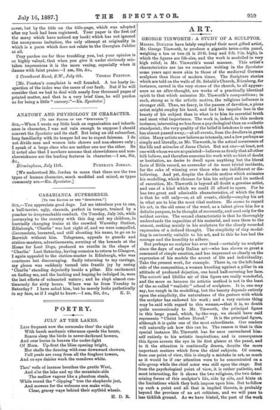ART.
GEORGE TINWORTH : A STUDY OF A SCULPTOR. blesses. Dourrox have lately employed their most gifted artist, Mr. George Tinworth, to procheze a gigantic terra-cotta panel, weighing a ton or two (it is 20 ft. long and Sit. Din, high), in which the figures are life-size, and the work is modelled in very high relief, in Mr. Tinworth's usual manner. This artist's characteristics are (as we remember writing in the Spectator some years ago) more akin to those of the medimval German sculptors than those of modern times. The Scripture stories which are told on the walls of St. Sebald's Church, Nurnberg, for instance, carved in the very stones of the church, to all appear- ance as an after-thought, are works of a practically identical spirit to that which animates Mr. Tin worth's compositions ; in each, strong as is the artistic motive, the religious influence is stronger still. Thus, we fancy, in the pauses of devotion, a pions artist might employ his hand, and find his impulse less in the beauty of his subject than in what is to him its essential truth and most vital importance. The work is, indeed, in this modern instance, interesting no less from a psychological than an msthetio standpoint; the very quality of the belief it betokens is one which has almost passed away,—at all events, from the dwellers in great cities. Many artists now believe as intensely, and a few perhaps as simply and literally, as Mr. Tinworth, in the actual occurrence of the life and miracles of Jesus Christ. But not one—at least, not one with whom we are acquainted—believes as firmly that all other folk believe, and therefore executes his work with no hint of doubt or hesitation, no desire to dwell upon anything but the literal facts of Bible record, no surrender of its most trivial incidents, for the sake of winning over those who are indifferent or dis- believing. And yet, despite the double motive which animates his modelling, which chooses for him his subject and its method of execution, Mr. Tinworth is beyond all doubt a genuine artist, and one of a kind which we could ill afford to spare. For he has two great and admirable characteristics, of which the first is that he will only—or, at all events, chiefly—employ his art in what are to him the most vital matters. He seems to regard his art, in the old sense of the word, as a talent given him for a definite purpose, to be thought of reverently, and used only for the noblest service. The second characteristic is that he thoroughly understands the capacities of his material, and uses them to the utmost, seeking mainly in his sculpture for the clearly recorded expression of a defined thought. The simplicity of clay model- ling is eminently suitable to his art, and to this he has had the courage and the humility to adhere.
But perhaps no sculptor has ever lived—certainly no sculptor since the days of early Italian art—who has shown so great a command of simple emotion, and has impressed so clearly on the expression of his models the accent of life and individuality. Take the present work, for example. There is, on the left-hand side of the composition, a woman kneeling against a pillar in an attitude of profound dejection, one hand half-covering her face. The naiveté and lifelike air of this figure are really wonderful, and the more so because its artistic method is not in the least
of the so-called " realistic " school of sculpture. It is, one may say, too rough in its modelling, but the beauty depends entirely
upon the simplicity, the naturalness of the gesture with which
the sculptor has endowed his work ; and a very curious thing may be said with regard to this woman,—that it is, no doubt quite unconsciously to Mr. Tinworth, the principal figure in this large panel, which, by-the-way, we should have said represents " Christ before Herod." It is the principal figure, although it is quite one of the most subordinate. Our readers will naturally ask how this can be. The reason is that in this special instance Mr. Tinworth has for once surrendered him- self entirely to his artistic inspirations, and in consequence this figure arrests the eye in its first glance at the panel, and to it the attention is continually drawn, despite the more important matters which form the chief subjects. Of coarse, from one point of view, this is simply a mistake in art, as much as it would be if our attention were to be concentrated on a side-group while the chief actor was still upon the stage. But from the psychological point of view, it is rather pathetic, and. most interesting, for it shows the two religions, the two deter-
mining forces of this sculptor's life, side by side, and hints at
the limitations which they both impose upon him. But to follow up such a point and all that is implied therein, is probably
beyond the province of an art criticism, and we will pass to leas ticklish ground. As we have hinted, the part of the work









































 Previous page
Previous page